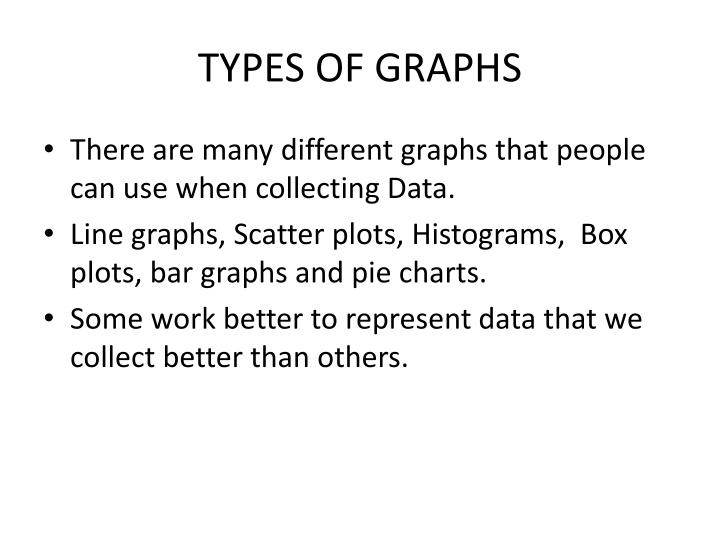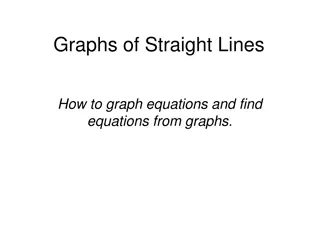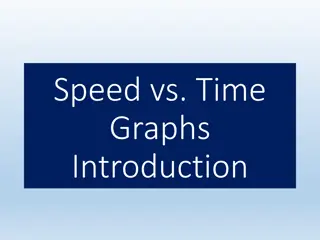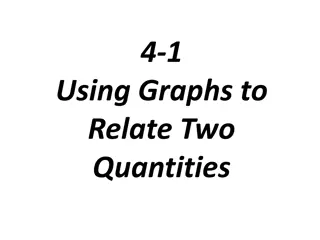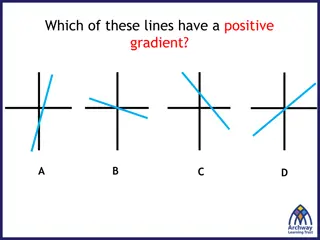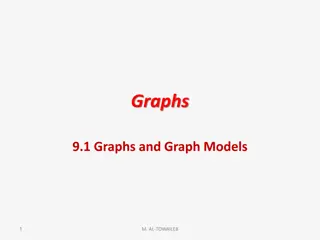Exploring Types of Graphs for Data Representation
Different types of graphs, such as line graphs, scatter plots, histograms, box plots, bar graphs, and pie charts, offer diverse ways to represent data effectively. Understanding when to use each type based on the data being collected is essential for insightful analysis. Scatter plots are ideal for showcasing correlations, while line graphs are suited for depicting changes over time. Histograms, dot plots, and box plots are valuable for exploring data variability, distribution, and central tendencies. Bar graphs are useful for comparing single numbers, making them great for assessing changes or differences in various metrics. This comprehensive guide delves into the significance and applications of each graph type in data analysis and interpretation.
Download Presentation

Please find below an Image/Link to download the presentation.
The content on the website is provided AS IS for your information and personal use only. It may not be sold, licensed, or shared on other websites without obtaining consent from the author.If you encounter any issues during the download, it is possible that the publisher has removed the file from their server.
You are allowed to download the files provided on this website for personal or commercial use, subject to the condition that they are used lawfully. All files are the property of their respective owners.
The content on the website is provided AS IS for your information and personal use only. It may not be sold, licensed, or shared on other websites without obtaining consent from the author.
E N D
Presentation Transcript
TYPES OF GRAPHS There are many different graphs that people can use when collecting Data. Line graphs, Scatter plots, Histograms, Box plots, bar graphs and pie charts. Some work better to represent data that we collect better than others.
Does it ask if there is a correlation? Are two numbers or factors correlated If so then you can use a Scatter plot or a Line Graph Height vs Shoe Size. Scatter plot. Something changing over time than use a Line Graph.
Scatter plots Is the Fuel efficiency of a car related to Weight? Are smoking rates correlated with medium income? How are temperature and pressure related to a fixed volume?
Line Graphs Have summer lake water temps increased over the last ten years? How have the height of humans changes over the past century?
Does your question ask about the variability of a group of data points? Such as the range of the data , the shape of the distribution, or what is the center of the data. Use Histograms, Dot plots or Box plot Examples: Do all high tides rise to the same height? What is the range and distribution of the incomes in the United States? How variable are wind speeds in Blaine?
Bar Graphs Use these graphs if you are comparing single numbers. Such as Median, Mean, or Total. Was the snowfall greater this year compared to last winter? How do Median incomes in the U.S. compare to the median incomes in Sweden?
Beware the Danger of Averages! Three statisticians went duck hunting. As a duck flew by, the first statistician shot at it, but was 10m too high. The second statistician shot at it, too, but was 10m too low. The third statistician exclaimed, We got it!
Statistics Statistical analysis is used to collect a sample size of data which can infer what is occurring in the general population More practical for most biological studies Typical data will show a normal distribution (bell shaped curve) Range of data Two important considerations How much variation do I expect in my data? What would be the appropriate sample size?
Measures of Central Tendencies Mean Average of data set Median Middle value of data set Not sensitive to outlying data Mode Most common value of data set standard deviation describes the variability in the data standard error of the mean determines your confidence in the sample mean.
Measures of Average Mean: average of the data set Steps: Add all the numbers and then divide by how many numbers you added together Example: 3, 4, 5, 6, 7 3+4+5+6+7= 25 25 divided by 5 = 5 The mean is 5
Measures of Average Median: the middle number in a range of data points Steps: Arrange data points in numerical order. The middle number is the median If there is an even number of data points, average the two middle numbers Mode: value that appears most often Example: 1, 6, 4, 13, 9, 10, 6, 3, 19 1, 3, 4, 6, 6, 9, 10, 13, 19 Median = 6 Mode = 6
Measures of Variability Standard Deviation It shows how much variation there is from the "average" (mean) Lower standard deviation: Data is closer to the mean Greater likelihood that the independent variable is causing the changes in the dependent variable Higher standard deviation: Data is more spread out from the mean More likely factors, other than the independent variable, are influencing the dependent variable
= standard deviation 68% of data fall within 1s of mean 95% of data fall within 2s of mean 99% of data fall within 3s of mean
The magnitude of the standard deviation depends on the spread of the data set Two data sets: same mean; different standard deviation
Calculating standard deviation, s 1. 2. Calculate the mean (x) Determine the difference between each data point, and the mean Square the differences Sum the squares Divide by sample size (n) minus 1 Take the square root 3. 4. 5. 6.
Calculating Standard Deviation Grades from a quiz 96, 96, 93, 90, 88, 86, 86, 84, 80, 70 Measure Number 1 2 3 4 5 6 7 8 9 10 TOTAL Mean, X Measured Value x 96 96 92 90 88 86 86 84 80 70 868 87 (x - X) 9 9 5 3 1 -1 -1 -3 -7 -17 TOTAL Std Dev (x - X)2 81 81 25 9 1 1 1 9 49 289 546 1st Step: find the mean (X)
Calculating Standard Deviation 2nd Step: determine the deviation from the mean for each grade then square it Measure Number 1 2 3 4 5 6 7 8 9 10 TOTAL Mean, X Measured Value x 96 96 92 90 88 86 86 84 80 70 868 87 (x - X) 9 9 5 3 1 -1 -1 -3 -7 -17 TOTAL Std Dev (x - X)2 81 81 25 9 1 1 1 9 49 289 546
Calculating Standard Deviation Measure Number 1 2 3 4 5 6 7 8 9 10 TOTAL Mean, X Measured Value x 96 96 92 90 88 86 86 84 80 70 868 87 Step 3: (x - X) 9 9 5 3 1 -1 -1 -3 -7 -17 TOTAL Std Dev (x - X)2 81 81 25 9 1 1 1 9 49 289 546 Calculate degrees of freedom (n-1) where n = number of data values So, 10 1 = 9
Calculating Standard Deviation Measure Number 1 2 3 4 5 6 7 8 9 10 TOTAL Mean, X Measured Value x 96 96 92 90 88 86 86 84 80 70 868 87 Step 4: (x - X) 9 9 5 3 1 -1 -1 -3 -7 -17 TOTAL Std Dev (x - X)2 81 81 25 9 1 1 1 9 49 289 546 8 Put it all together to calculate S S = (546/9) = 7.79 = 8
Calculating Standard Error So for the class data: Mean = 87 Standard deviation (S) = 8 1 s.d. would be (87 8) thru (87 + 8) or 81-95 So, 68.3% of the data should fall between 81 and 95 2 s.d. would be (87 16) thru (87 + 16) or 71-103 So, 95.4% of the data should fall between 71 and 103 3 s.d. would be (87 24) thru (87 + 24) or 63-111 So, 99.7% of the data should fall between 63 and 111
Measures of Variability Standard Error of the Mean (SEM) Indication of how well the mean of a sample (x) estimates the true mean of a population ( ) Measure of accuracy, if the true mean is known Measure of precision, if true mean is not known As SE grows smaller, the likelihood that the sample mean is an accurate estimate of the population mean increases
Accuracy How close a measured value is to the actual (true) value Precision How close the measured values are to each other.
Calculating Standard Error, SE 1. 2. Calculate standard deviation Divide standard deviation by square root of sample size
Calculating Standard Error Using the same data from our Standard Deviation calculation: Mean = 87 S = 8 n = 10 SEX = 8/ 10 = 2.52 = 2.5 Bozeman video: Standard Error This means the measurements vary by 2.5 from the mean
How do we use Standard Error? Create bar graph mean on Y-axis sample(s) on the X-axis chemical 1 mean = 30 cm chemical 2 mean = 50 cm
Add error bars! SE Indicate in figure caption that error bars represent standard error (SE)
Analyze! Look for overlap of error lines: If they overlap: The difference is not significant If they don t overlap: The difference may be significant
Which is a valid statement? Fish2Whale food caused the most fish growth Fish2Whale food caused more fish growth than did Budget Fude
Statements: In all four regions, more males exhibited the trait measured than did females. More males in region 3 exhibited the measured trait than did females
Mean belief scores for misleading ads vmPFC = damage to ventromedial prefrontal cortex BDC = brain damaged comparison group # of ads identified as misleading Statements: 1. The vmPFC group identified fewer ads as misleading than did the normal group 2. The BDC group identified more ads as misleading than did the normal group.
Consider these 3 plant populations: When two SEM error bars don't overlap at all (like Pop. 1 and Pop. 3), and they are representing +/- 2 SEM, then you can be 95% confident there is a significant difference between the two populations (you can do other statistical tests to affirm this). (You can say, the difference between Pop. 1 and Pop. 3 is significant at p<0.05 .) When the +/- 2 SEM error bars do overlap but don't overlap the mean then you don't really know without a test--it might be or might not be a significant difference. Comparing Pop. 2 and Pop. 3 is this type of situation. Finally, if the error bars overlap and that overlap includes the means, then you can be fairly confident there is no real difference. This is the situation comparing Pop. 1 and Pop 2.
Little overlap, likely to be significantly different So much overlap, may not be significantly different
